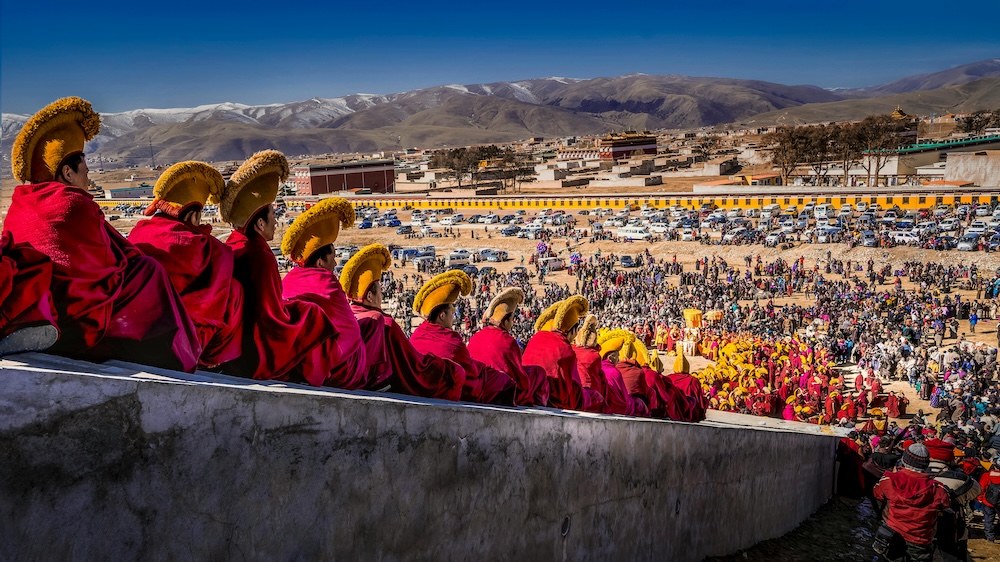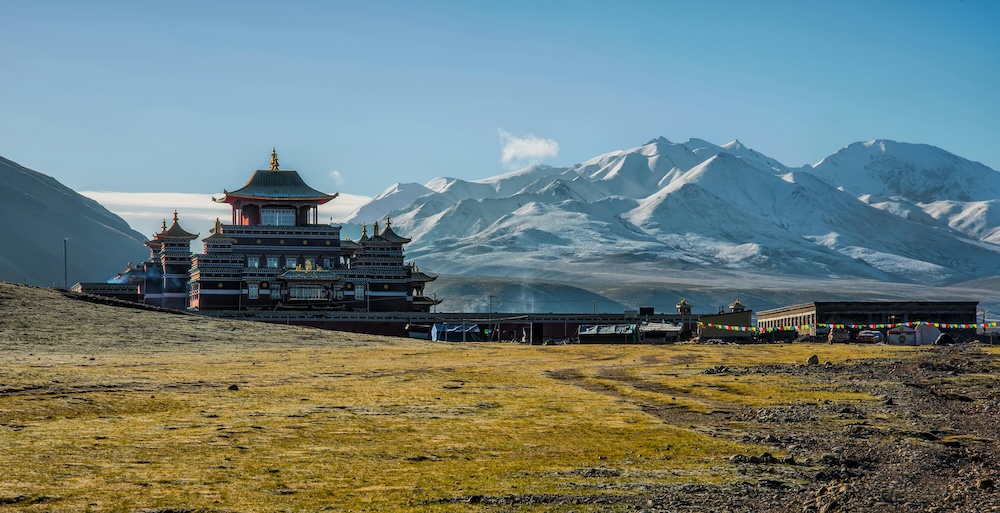Since the beginning of consciousness, people have been confused by death. Most religious traditions, on the other hand, only make vague promises of paradise or threats of hell. The Tibetan Buddhist tradition offers a comprehensive and systematic delineation of the experiences of consciousness during the 49 days subsequent to death. The Bardo Thodol, also known as the Tibetan Book of the Dead in the West, contains this map. It is one of the most advanced and useful guides to death, consciousness, and spiritual transformation ever made.
The Secret Sources of Sacred Knowledge
The amazing story of this text starts not in the 14th century, when it was found, but in the 8th century, when it was first hidden. Padmasambhava, the Indian tantric master who brought Buddhism to Tibet, had a deep understanding of what would happen in his new home. He hid important teachings in what Tibetans call "terma," which means "hidden spiritual treasures," because he knew that Tibet would go through times of persecution and spiritual decline.
This practice of hiding knowledge shows a deep understanding of spiritual timing. Padmasambhava put texts, ritual objects, and teachings in different places in the Himalayas and in the minds of his most advanced students. Dakinis and guardian spirits kept these treasures safe until the right time came for them to be revealed, when they would have the most positive effect.

Karma Lingpa, a 14th-century "terton" or treasure revealer, found the Bardo Thodol as part of a larger cycle called the "Profound Dharma of Self-Liberation Through the Intention of the Peaceful and Wrathful Ones." The original Tibetan title means "Liberation Through Hearing During the Intermediate State," which is a much better description than the dramatic English name it would later get.
Misinterpretation and Cultural Translation
The text's journey to Western consciousness shows interesting patterns of cultural transmission and unavoidable distortion. Walter Evans-Wentz published the first English translation in 1927 and gave it the title "The Tibetan Book of the Dead" to make it sound like the Egyptian Book of the Dead, even though the two texts don't have much in common other than being about death rituals.
Evans-Wentz's main job was to edit the text. The actual translation was done by Kazi Dawa Samdup, a brilliant Sikkimese scholar who was the headmaster of a boarding school and worked as an interpreter for the British colonial government. But Evans-Wentz's work with Theosophy had a big impact on the presentation, bringing in ideas that came from Hinduism and Western spiritualism rather than real Tibetan Buddhism.
Even with these problems, the text had a strong effect on Western seekers. Carl Jung wrote an important commentary that used analytical psychology to explain the bardos. He saw the peaceful and angry gods as archetypal projections of the unconscious mind. Timothy Leary, Ralph Metzner, and Richard Alpert changed the text in the 1960s counterculture movement to be a guide for psychedelic experiences. This made it even more important in Western spiritual exploration.
Understanding the Intermediate States
The idea of "bardo" is what this whole system is based on. The word "bar" means "movement or flow, like a stream," and "do" means "a stepping stone or island." This word captures something deep about consciousness itself: every moment is an intermediate state between the past and the future, creating islands of awareness within experience's flowing stream.
Traditional Tibetan Buddhism recognizes six bardos that encompass the entirety of existence's cycle. The Bardo of This Life goes from birth to death. It is the state of waking consciousness where we build up karma through our actions, thoughts, and intentions. Every night, the Bardo of Dreams happens. It shows us how experiences are not real, which we only fully understand after we die. The Bardo of Meditation refers to states of deep concentration in which practitioners directly perceive the fundamental nature of the mind.
The Bardo Thodol's main focus is on the three bardos that are connected to death and rebirth. The Bardo of Dying includes the process of dying from a serious illness or injury until consciousness finally stops. The Bardo of Dharmata comes right after death, when consciousness meets the true nature of reality. The Bardo of Becoming is the time before rebirth when a person is in a transitional state. It can last up to 49 days.
The Clear Light and the Dissolution Process
Tibetan beliefs say that death happens in eight steps, not all at once. Earth, water, fire, and air are the physical parts of the body. Over time, these parts stop working, and our consciousness and perception change in response.
As the earth element breaks down, the body gets weaker, and the person who is dying may feel like they are sinking or being crushed. When water dissolves, it makes you very thirsty because your body fluids dry up. When fire dissolves, it makes the body feel cold. When air dissolves, it makes breathing harder and shallower.
These physical dissolutions are just the beginning of the biggest changes: the dissolution of consciousness itself. As conceptual thought ceases, the mind undergoes progressively subtle states, perceived as white (resembling a clear autumn sky), red (akin to sunset), and ultimately black, accompanied by sensations of faintness.
The Clear Light of Death's dawning comes after these three stages. This is the most important part of the death process. This shows the mind's most basic nature: pure, bright awareness that isn't based on any ideas. Buddhist texts characterize it as "a clear, luminous, vacuum-like empty sky" or "a transparent vacuum devoid of circumference or center."
For highly trained meditators, this moment presents the ultimate opportunity for liberation. Understanding the Clear Light as the ultimate nature of reality—not empty space, but consciousness itself—facilitates immediate enlightenment. The practitioner becomes one with the Clear Light and is completely free from the cycles of birth and death.

Advanced practitioners can stay in this state for days after clinical death. This is called "tukdam." The body shows very few signs of decomposition, and teachers say not to touch it because they believe that consciousness stays present during deep meditation.
Meeting Peaceful and Wrathful Deities
Most people can't handle or even see the Clear Light's overwhelming brightness. After staying for a few minutes to three days, unrecognized consciousness starts to move through the next bardo states and into what Tibetans call the Chonyid Bardo, or the Bardo of Experiencing Reality.
During the first week of this phase, consciousness meets 42 peaceful deities. These are Buddha Vairochana, who stands for purified delusion; Akshobhya, who stands for purified anger; Ratnasambhava, who stands for purified pride; Amitabha, who stands for purified desire; and Amoghasiddhi, who stands for purified jealousy. Each one comes with partners and is surrounded by bodhisattvas, goddesses, and attendants, all of whom give off bright light and make loud noises.
Consciousness moves into the second week and meets 58 wrathful deities because it doesn't see these peaceful deities as projections of enlightened nature. These heruka deities with many heads and arms, wearing skull garlands, drinking blood from skull cups, and being surrounded by flames look very scary. Four gatekeepers stand in each cardinal direction, making it impossible to get away.
The main lesson is that these appearances aren't real things; they're karmic projections—visual representations of the actions, thoughts, and tendencies that consciousness has built up over time. Peaceful deities symbolize beneficial karmic accumulations and the potential for liberation, whereas wrathful deities embody intense compassion aimed at awakening consciousness to recognition.
The Path to Rebirth
If you don't get free during a meeting with a deity, your mind goes to the Sidpa Bardo, which is the Bardo of Becoming. This last phase can last up to 49 days, and every seven days there is a chance for rebirth.
In this middle state, consciousness has a "mental body" that can move through space instantly, go through solid objects, and go anywhere it wants just by thinking about it. But it suffers a lot because it doesn't want to die and is still attached to its old life.
The dead person's consciousness sees loved ones crying, sees food being set aside, and sees the body being prepared for burial. It screams, but no one can hear it, which causes a lot of pain and confusion. The consciousness also experiences overwhelming sensory phenomena arising from its own karma.
Buddhist cosmology delineates six potential realms of rebirth: the god realms, characterized by pride and delusions of immortality; the jealous god realms, marked by conflict and competition; the human realm, which balances suffering with opportunities for awakening; the animal realm, dominated by ignorance and instinct; the hungry ghost realm, tormented by insatiable craving; and the hell realms, where intense karmic purification suffering is experienced.
According to its karma, consciousness is drawn toward rebirth as the 49 days go by. From every realm, light comes. The light from the lower realm looks bright and pretty, but the light from the higher realm, especially the liberation path, looks bright and scary. The instruction says, "Don't run away from bright, painful light." Don't hide in the shadows where it's comfortable. "Follow the light that scares you."
Practical Application and Purpose
The Bardo Thodol is an active tool, not just a philosophical idea. A lama starts reading the right parts even before the person dies, and they keep reading them for the next 49 days. Each part corresponds to an experience that the person's consciousness is thought to have.
After death, a white cloth covers the face, and no one touches the body for three days. This is part of the traditional practice that lets people have the Clear Light experience. The body is placed on its right side in the "Lion Posture." Some customs make an effigy out of the dead person's clothes and keep it in the house for 49 days while lamas chant and families give gifts.
The text serves as a meditation guide for the living, not just as a literal guide. Practitioners get ready for death while they are still alive by studying the bardos. The text teaches that sleeping, dreaming, and waking are like little deaths. Each night, when we fall asleep, we go through stages of dissolution that are similar to dying. When we wake up, we are reborn.
Modern Interpretations and Relevance
Modern readers have discovered significant relevance beyond conventional Buddhist frameworks. Carl Jung's psychological analysis posited that the peaceful and wrathful deities symbolize archetypal elements of the collective unconscious, rendering the text pertinent for comprehending human psychology irrespective of specific afterlife convictions.
Researchers observe compelling similarities between Bardo Thodol descriptions and accounts of near-death experiences. The transition from darkness to radiant light, interactions with deceased relatives, life evaluations, and profound peace experiences reported by clinically dead individuals exhibit significant similarities to bardo teachings, despite emerging from entirely distinct cultural contexts.
The text is a metaphor for any big change in life. Relationship endings, job loss, serious illness, or retirement can be seen as "bardo" states, which are uncomfortable places in between where old life has ended but new life hasn't begun. Instructions on how to recognize projections, face fear, and choose hard but freeing paths become useful for everyday problems.
The Ultimate Teaching
The most important thing the Tibetan Book of the Dead says is that death is not something that happens to us; it is something we do. The state of our consciousness at the moment of death, influenced by our actions and mental habits throughout life, dictates our experiences in the bardos.
Death becomes an opportunity rather than a catastrophe for those who have trained their minds through meditation, study, and ethical conduct. The Clear Light that comes at death is the same basic awareness that is present in every moment of life; we just don't notice it because of our thoughts, emotions, and senses. Death takes away these things that keep us from seeing the true nature of our minds.
The text keeps saying that freedom is always possible. Not seeing the Clear Light can lead to opportunities during peaceful deity encounters. Wrathful deities give you another chance if you miss those. There is always help available for those who can hear and understand during the 49-day journey.
There is both fear and hope in this lesson. It's scary to realize that we are basically alone in facing these problems—no one can die for us or see the Clear Light for us. Hope comes from knowing that freedom is always possible, and that the scary visions we see are really just things we made up that go away when we see them for what they are.
